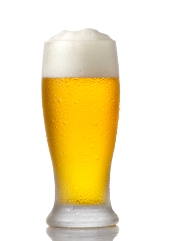Krausening is a traditional German method for carbonating beers without using sugars or other adjuncts. Instead actively fermenting malt wort is added to the fermented beer to provide the malted sugars needed for carbonation.
The History of Krausening
 The “Reinheitsgebot”, or German purity law, originated in Bavaria in 1516. It specifies that beer may only be made from the three basic ingredients: malt, hops, and water. Interestingly yeast was left out of the original law as it was unknown until Louis Pasteur discovered microorganisms in the late 1800’s. It was recently replaced by the “Biergesetz” in 1993, which also allows the use of malted wheat and cane sugar, though the term “Reinheitsgebot” is more commonly used.
The “Reinheitsgebot”, or German purity law, originated in Bavaria in 1516. It specifies that beer may only be made from the three basic ingredients: malt, hops, and water. Interestingly yeast was left out of the original law as it was unknown until Louis Pasteur discovered microorganisms in the late 1800’s. It was recently replaced by the “Biergesetz” in 1993, which also allows the use of malted wheat and cane sugar, though the term “Reinheitsgebot” is more commonly used.
Since sugars were not allowed in beer, malt wort was used instead. Krausening was widely used in Germany particularly for lagers. Many lagers are cold fermented and aged, often causing the yeast to go dormant. By adding actively fermenting wort for carbonation the lager could be properly carbonated. Krausening was less commonly used in Kolsch or Alt, as these ales were fermented at warmer temperatures leaving active yeast.
Krausening
In a brewery, krausening would be done with fresh wort taken from the most recent batch made. For the homebrewer, Krausening is most often done with a small amount of wort made from dry malt extract. Alternately you can use a fresh batch of wort or keep some wort in a sterile container in the refrigerator from your last batch.
A key question is how much wort to use for proper carbonation? A good rule of thumb is that you should add enough wort to raise the gravity of the beer three points. For simplicty you can try the following formula from the Home Brewing Wiki:
Quarts_of_wort = (12 x Gallons_of_beer) / ((Specific_gravity_wort – 1.0) * 1000)
For example, if the krausening addition of wort (also called gyle) has a specific gravity of 1.060, and we’re krausening 5 gallons of beer, the result would be (12 x 5)/((1.060-1)*1000) which works out to exactly one quart of wort we add at bottling.
Traditionally, the krausening addition is added at the most active point of fermentation. Ideally you should add yeast to your krausen and monitor it for active fermentation, but try to catch it before a lot of the malt sugars have been consumed. You need to measure the specific gravity of the krausening addition and do the above calculation before adding it to the wort to get the appropriate amount.
After you add the krausening wort, you can bottle or keg your beer and naturally carbonate it just as you would if you were with sugar carbonation. Store your beer in a cool, dark place for a week or two to allow it to carbonate and then lager or age as desired.
Krausening is a great way to add some variety to your beer brewing techniques, and assure that your beer is made from pure barley malt. Thanks again for joining us on the BeerSmith Home Brewing Blog. Please subscribe or retweet this article if you enjoyed it! Have a great brewing week!
Thanks for the handy formula. I’ve never bothered with krausening because adding 3/4 cup of corn sugar at bottling time is so darned easy, and I can’t imagine it makes any difference in the beer. (Other than carbonation, of course.)
You said, “Traditionally, the krausening addition is added at the most active point of fermentation.”
I’m not sure exactly what you mean by that, but for the homebrewer it’s important to make sure the unfermented wort is added at bottling time — after fermentation has completed.
Actually traditional krausening is done with a measured amount of wort that also has yeast added to it. The yeast addition is most appropriate for lagers where the cold aging may have turned the original yeast dormant. For the krausen with yeast, you need to add the yeast 12 hours or more ahead of time so that it is actively fermenting when you add the krausen gyle to the beer.
Interesting article, often wonder if Krausening is done because it is a tradtion rather than a must. Does the process help to give a dryer flavour?
MW
I would say it is not necessarily a drier flavor. If done with the same wort as the original it should, in theory, impart no change in flavor from the original beer.
I wrote that initial wiki article and have since revised the formulas to calculate the volume of Krauesen needed:
http://braukaiser.com/wiki/index.php/Kraeusening
Cheers,
Kai
I have tried krausening twice. The first time worked great, the second I made beer bottle bombs.
Batch Sparging
Pingback: Krausening Home Brewed Beer | The Homemade Wine Blog
Pingback: Priming with unpitched wort - Home Brew Forums
How much carbonation can I expect from that formula?
Pingback: The Man Who Invented Beer: Genesee Cream Ale | Heave Media
Pingback: Estilos de Cerveza III (Lager) | El Templo de Ninkasi
Pingback: Exploring the German Technique of Krausening | American Homebrewers Association
Pingback: Carbonation Options for Your Home Brewed Beer - Hellbach blog
Pingback: Anchor Brewing Company, San Francisco, CA | Brew Bloggers
Pingback: Visit to Anchor Brewing – BeerByNumber.com
Pingback: Put Diaceytl to Rest
Pingback: Another Diacetyl Review – BrewQualitySolutions.com
Hey Kai, i read your article on krausening, but im loking for something that no one seems to have, kegging or bottling beer that is not fully finish fermenting,so basically using the remaining gravity to bottle or keg condition the beer, are there any articles anywhere?